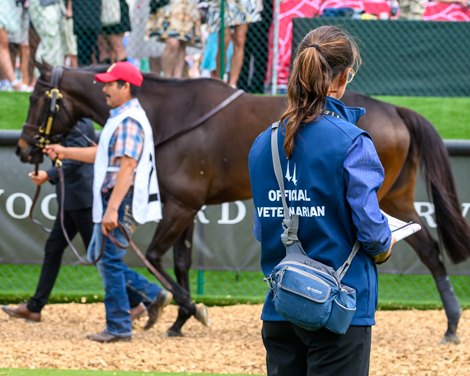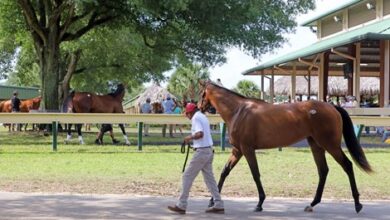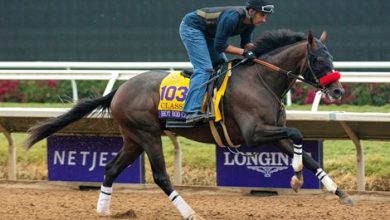HISA: No Single Explanation for Churchill Fatalities

A Horseracing Integrity and Safety Authority investigation into a dozen equine fatalities this spring at Churchill Downs yielded no singular explanation for the incidents, according to a report released Sept. 12 by HISA. But the “absence of a singular explanation underscores the urgent need for further action and analysis to mitigate risk stemming from several factors potentially contributing to equine fatalities,” the organization said in a statement about its report.
HISA’s investigation evaluated three primary factors: 1) the potential role of Churchill Downs’ racetrack surfaces in the breakdowns, 2) veterinary records including the necropsies of each of the 12 horses, and 3) any potential rules violations or procedural deficiencies that may have contributed to the fatalities.
The report of the investigation, which can be viewed online, concluded: “There was no causal relationship between the racetrack surface at Churchill Downs and the equine fatalities. Similarly, there was not a clear pattern in medical histories or injury profiles across the fatalities that point to a single, causal explanation for the fatalities. Nor were there any medication violations present. However, analysis of training histories did indicate an increased risk profile for some of the horses due to the frequency and cadence of their exercise and racing schedules. HISA has shared recommendations on track surface testing and maintenance with Churchill Downs and offers additional procedural improvements for the tracking and reporting of injuries to better inform the development of additional rules.”
The release of HISA’s findings comes more than three months after the Churchill Downs spring meet was moved to Ellis Park in Western Kentucky in alignment with a recommendation from HISA so Churchill Downs, the Kentucky Horse Racing Commission, and HISA to review all safety and surface protocols and integrity measures in collaboration industry experts. The Churchill Downs at Ellis Park meet, as well as the traditional Ellis Park summer season, were completed under safer and more typical conditions. Churchill Downs Inc. owns Ellis Park.
Horses continued to train at Churchill Downs through the spring and summer.
HISA’s findings come two days before Churchill Downs is to begin its next meet Sept. 14.
The HISA report mirrors those more preliminary findings from the HISA, the KHRC, and Churchill Downs, which similarly could not identify specific causes for the fatalities.
Officials have long said that spikes in breakdowns, such as one that occurred at Santa Anita Park in early 2019 or this summer at Saratoga Race Course, are typically multifactorial in nature. The fatalities at Saratoga came under the regulatory oversight of HISA, which did not initiate action to suspend or move that meet. HISA did announce in late August an expanded review of the circumstances surrounding recent equine fatalities there.
“HISA’s most important mission is to protect the health and well-being of the horses participating in Thoroughbred racing,” said HISA CEO Lisa Lazarus. “The events at Churchill Downs, Laurel Park and Saratoga Race Course this spring and summer were a sobering reminder of the complexity of that mission. We must create a culture of safety and an ecosystem of care that takes into account all factors contributing to equine fatalities. And it is the responsibility of all racing participants to do their part. That is why HISA is making ambitious recommendations and further mandates to ensure everyone involved in the sport acts, first and foremost, in the best interest of the horse. Racing can and must do better.”

CEO HISA Lisa Lazarus
The fatalities at Churchill Downs occurred on the dirt track and turf course, in racing and during training. One accident occurred in the paddock. At least three of the equine fatalities are not breakdowns—the paddock accident and two sudden deaths during or shortly after races on the turf course.
In late May, veterinary officials from HISA, Churchill Downs Inc., and the Kentucky Horse Racing Commission held an emergency veterinary summit. Additionally, track surface experts Dr. Mick Peterson and Dennis Moore examined the track surfaces and found them consistent with how they had been in past seasons.
Earlier this year, Churchill Downs modified its racing procedures, such as restricting the number of starts per horse to four during a rolling eight-week period and prohibiting horses beaten by more than 12 lengths in five consecutive starts from racing at Churchill Downs until approved by Churchill Downs Inc. equine medical director Dr. Will Farmer to return.
Additionally, the track has placed restrictions on older first-time starters and horses coming off long layoffs that require consultation and approval from either KHRC veterinarians or by Farmer.

CDI equine medical director Dr. Will Farmer
One change announced in early June—a suspension to purse payout allocations to every race finisher—is no longer in place. Payments for Kentucky Thoroughbred Development Fund-eligible horses will extend through last place, it was announced in August.
Saying that “action must be taken in reaction to what we know and what we do not know, for the welfare of Thoroughbred
horses,” HISA said its strategic response plan to address equine fatalities across the country calls for the following:
- A robust data analysis effort in which HISA will work with top data analytics companies to explore critical questions facing the sport with the intent to yield new, actionable insights into factors contributing to equine fatalities.
- And the creation of a Blue-Ribbon Committee to work toward the study and ultimate introduction of more synthetic surface options in Thoroughbred racing. Synthetic surfaces are statistically safer than both dirt and turf tracks.
Additionally, HISA called for improved veterinary screening and diagnostic procedures including:
- Making equine positron emission tomography scans more accessible to racetracks across the country. (Churchill Downs and Santa Anita Park are two tracks with PET scanners.)
- Conducting a research study to examine the causes of exercise-associated sudden deaths.
- Further use of wearable technology as an injury detection tool.
- An examination of whether there are any other equine fitness tools worthy of investment and deployment.
Lazarus and HISA Racetrack Safety Committee chair Dr. Susan Stover have scheduled a video conference with media early this afternoon to discuss the report.
This story will be updated.




